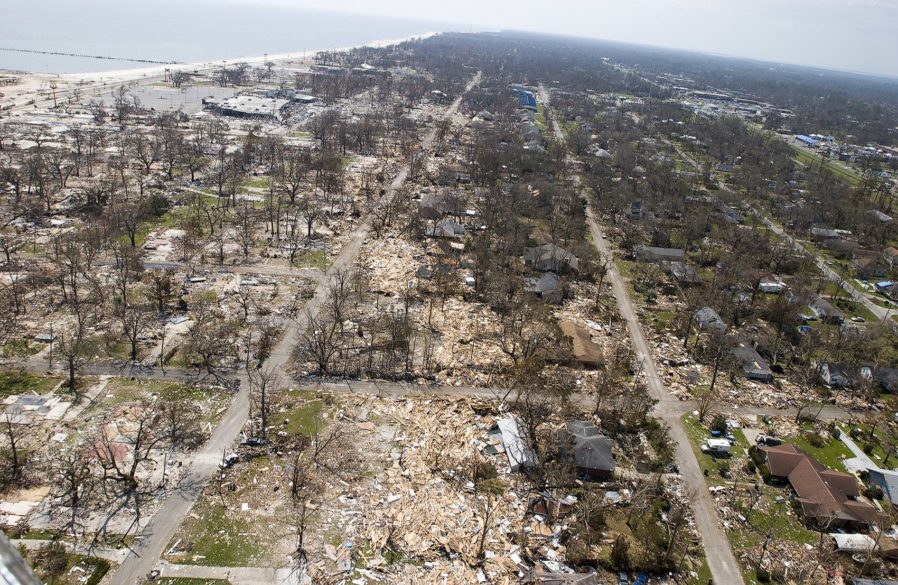From the Archives
By Mary Woodward
JACKSON – In Mississippi, the month of August stirs a myriad of thoughts of the “3-H’s” for which we are so well-known – heat, humidity and hurricanes. This August is no different. I would like to share a couple of memories of Augusts gone by.
Two of the worst hurricanes to make landfall in the history of the state and country were August hurricanes named Camille (Aug. 17 and 18, 1969) and Katrina, which actually made landfall first across Miami on Aug. 23, 2005, then again in Mississippi on Aug. 29.
Well, let me now date myself. I remember Hurricane Camille. We grew up on Millsaps College campus in Jackson in faculty housing. When Camille came ashore 170 miles south of our house, the old-style metal two-inch green Venetian blinds stood out from the windows rattling in the wind all night long. That image is forever etched in my mind.

Prior to destroying all wind measuring tools, Camille was clocked at a one minute sustained 175 mph winds with a 25-foot storm surge. She was fierce and became the benchmark of storms for years to come until 2005, when Katrina made her way toward the Gulf Coast.
What many may not remember is Katrina had already made landfall near Miami and caused widespread flooding and power outages there a week before. I remember because Bishop Joseph Latino was in Miami when the first landfall occurred. He had that kind of luck throughout his life.
As I watched the path of Katrina develop, it became eerily similar to Camille’s path straight up the Gulf. When I picked up Bishop Latino at the airport upon his return from Miami a few days after the initial landfall, I made the remark that Katrina was following him. There was definitely a bad feeling about this storm.
That weekend, the Cathedral in Jackson experienced standing room only congregations – filled with evacuees from the Gulf Coast and Louisiana. As people came forward in the communion line, there was not a dry eye in the house.
While Katrina was making landfall early Monday morning, we in the chancery office were sent home and told to be where we needed to be for the next 12 hours by 11 a.m. When I arrived home after dropping off a couple of cases of Catholic Extension Bibles for evacuees at the Coliseum, I hunkered down with my pimento cheese and Zapp’s. Taking comfort in the fact that my 70-year-old house had survived Camille, I watched the news until the power was knocked out around noon.
Still, I was confident in the structure of my house even when the attic turbine snapped off, bounded down the roof and landed at my feet on the back porch. I was losing confidence when I took my nearly decapitated self into the attic to put a bucket under the hole in the roof left by the now absent turbine. I recall thinking “next stop Oz.”
After what seemed like a 10-hour tornado in slow motion, the next morning I ventured out following the sounds of the chainsaw to get neighbors to put me on their list of tree removal. They came and dispatched the tree on the fence, shared some cold water I had in an ice chest (I was prepared because of the really bad feeling about the storm), and moved on to the next neighbor.
We all pulled together to help because we knew if it was this bad in Jackson, it had to be 1000 times worse on the Coast. I recollect seeing the helicopter flyover of the Gulf Coast – we were wrong – it was a million times worse. Who could have ever imagined worse devastation than Camille? Those thoughts entered my mind in the attic the night before, but the reality of it in one flyover report removed all doubt.
After a day of clean up in the neighborhood, the next day provided a chancery office with electricity and air-conditioning. It also became a hub for evacuees to come and use email and Facebook on our computers to let family and friends around the world know they were ok.
Indeed, it was quite the time in Jackson, but nothing in comparison to our friends at the chancery office in Biloxi whom we did not know whether they were ok or not for a full two days due to shattered communication lines and towers.
From an archive’s perspective, after dealing with the humanitarian needs of these disasters, thoughts turn immediately to sacramental registers in destroyed churches. These registers contain our sacramental lives, which are often used to establish identity, get a passport and obtain pensions. In our diocese, every 10 years we bring in these registers and make copies of the contents in the event of such a disaster.
Because there were microfilm copies of registers in 1969, parishes that may have lost registers to the storm were able to get copies of them. Ideally, these registers would be stored in secure environments, but that is not always possible.
As we move through August and the Gulf continues to heat up, this is a prime time for parishes to reexamine plans for sacramental register safekeeping. Simple things such as large Ziploc bags on hand and portable watertight containers available can go a long way in protecting these lifelines for parishioners and the church.
Another handy thing to have is a disaster clean up kit in a bucket that includes bleach, gloves, masks and scrubbing brushes. As I write this, I remember there is a bucket is still in my attic… Take care and stay safe.
(Mary Woodward is Chancellor and Archivist for the Diocese of Jackson.)
